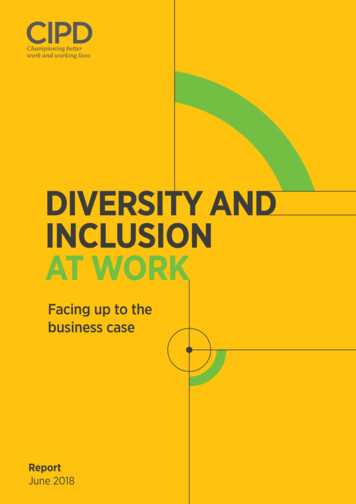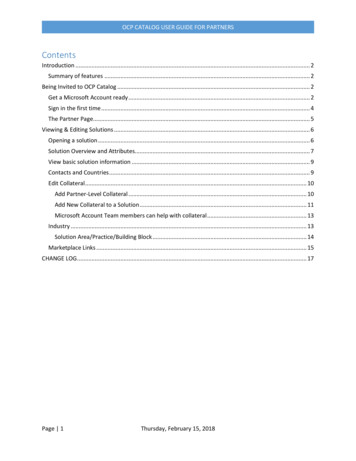
Transcription
Facing up to thebusiness caseReportJune 2018
The CIPD is the professional body for HR and peopledevelopment. The not-for-profit organisation championsbetter work and working lives and has been setting thebenchmark for excellence in people and organisationdevelopment for more than 100 years. It has more than145,000 members across the world, provides thoughtleadership through independent research on the world ofwork, and offers professional training and accreditation forthose working in HR and learning and development.
Diversity and inclusion at work: facing up to the business caseReport12Diversity and inclusion at work:facing up to the business case34567Contents1Introduction 22Why focus on diversity and inclusion? 43What are the outcomes of diversity? 74What factors keep inequality in place at work? 135What supports greater inclusion and diversity in the workplace? 206Diversity and inclusion at work: where to next? 247References 28AcknowledgementsThis report was written by Mel Green, Heather Bond, Jill Miller and Jonny Giffordof the CIPD.We would also like to thank Barbara Janssen for her guidance and assisting inthe critical appraisal phase of the rapid evidence assessment that forms thebasis of this research report.1
Diversity and inclusion at work: facing up to the business case11234567IntroductionDespite equality legislation and a recognition by many organisations that diversity andinclusion is important, we know that inequality still exists in the workplace. For example,in the UK, gender pay gap reporting has shone a light on the structural barriers toprogression in organisations for women, including a lack of senior role models and flexibleworking. We also know that racial background can affect both access to work and theopportunities received for progression (CIPD 2017a). Furthermore, research tells us thatdiscrimination still very much exists, both in its blatant form and via unconscious bias,which impacts numerous minority groups (Jones et al 2017, Talaska et al 2008).Positively, diversity and inclusion is rising up the agenda in many organisations. However,the pace of progress towards realising equality of opportunity is still painfully slow. Weneed more evidence of what works to help guide organisations’ efforts and galvaniseaction to remove barriers to equality.The moral case for diversity and inclusionThere is a compelling moral case for diversity and inclusion in the workplace and beyond.Ensuring everyone is treated equally, with dignity and has their fair share of resources(whether that be access to work or equitable pay) is simply the right thing to do. Work isa key aspect of our lives, so when work is not good for everyone it has the ability to createbarriers, such as marginalisation and discrimination that impact on different groups insociety (Hocking 2017).‘Diversity and inclusion is rising up the agenda in manyorganisations. However, the pace of progress towards realisingequality of opportunity is still painfully slow. We need moreevidence of what works to help guide organisations’ effortsand galvanise action to remove barriers to equality.’Therefore, organisations have a key part to play in tackling inequality, encouragingdiversity and creating an inclusive workplace culture. An inclusive organisation (and indeedlabour market) enables anyone, regardless of their identity, background and circumstance,to thrive at work and have equal access to jobs that positively benefit them. People matter,and we all should have equal opportunity to develop, progress, and be rewarded andrecognised at work. Organisations must ensure that their people management practiceschampion this fundamental principle.The business case for diversity and inclusionThere is also still the need to provide a financially driven business case for action for somebusiness leaders (although the moral case should be sufficient). This business case fordiversity focuses on what diversity can do for organisational performance, built on thewidely accepted belief that diversity and inclusion yields positive performance outcomesfor organisations.It is important to understand the relationship between diversity and performance, andunder what conditions diversity can lead to positive outcomes. But, by being inclusiveand supporting diversity, organisations (and importantly, the individuals within them) maybenefit in a variety of ways that are not typically measured, such as retention of diversetalent, employee satisfaction and well-being. Previous research has also highlighted thatthe link between diversity and performance is not conclusive – but this does not mean2Introduction
Diversity and inclusion at work: facing up to the business case1234567organisations should be deterred from pursuing diversity (Department for Business,Innovation and Skills 2013). This research aims to uncover the evidence behind thebusiness case argument, while highlighting that there is a need to challenge this traditionalnotion of the ‘business case’ that focuses only on financial, rather than human, outcomesand other business outcomes such as corporate reputation. Despite an often over-relianceof business leaders and default focus on the narrow business case, we argue that anybusiness case for diversity should hold these outcomes in balance and recognise thebenefits at not only an organisational level but from an individual and societal perspective.We believe the people profession must champion a progressive perspective on the creationof value that considers a broad range of stakeholders and challenges a narrow focus onmaximising shareholder value (CIPD 2018).Limited progress and a lack of evidenceIt is evident that people management practices, alongside the culture and values of anorganisation, hold the key to unlocking truly inclusive working practices that add valuebeyond compliance with equality legislation. People professionals have a key part to playin ensuring that what is espoused in policies is acted out in practice, ensuring fairness andencouraging diverse voices to be heard.Unfortunately, while many organisations prioritise diversity and inclusion, action is oftennot guided by clear knowledge of what works, and under what conditions. We need thisknowledge to take informed, evidence-based action, and to be able to examine what willmake a difference as well as what organisational factors are unhelpfully serving to maintainthe status quo.To help address the issues outlined above, this research aims to answer the followingquestions as a basis for this evidence-based action:1 What are the outcomes of diversity?2 What factors keep inequality in place at work?3 What supports greater inclusion and diversity in the workplace?To answer these questions, we conducted a rapid evidence assessment (REA). Asdescribed in Box 1, this is a systematic method of identifying the best available evidenceon these questions, drawing on published scientific research.Box 1: The rapid evidence assessment (REA) methodologyA rapid evidence assessment is conducted to find the best availableevidence on certain topics. By best available evidence, we mean theevidence that can identify, at best, a causal relationship between twovariables of interest and potential moderators and mediators of thatrelationship. As part of this, the quality of studies identified in a literaturesearch are assessed and only included if they use specific types of researchmethodology that are appropriate and trustworthy.While no research findings are infallible, several indicators can be used toassess how valid and reliable, and therefore trustworthy, the evidence is.In other words, does the study measure what it sets out to measure, andwould the same results occur if the same study was conducted again?These are all indicators of methodological quality in experimental andcross-sectional research.Continued on next page3Introduction
Diversity and inclusion at work: facing up to the business caseIn addition, the method of the study is important when we want to answer acause and effect question (does A lead to B, and under which conditions?).1A randomised, controlled trial examining the relationship between twofactors are the ‘gold standard’ for causal research questions – and going onestep further, meta-analytic or systemic reviews that bring together the resultsof multiple randomised controlled trials are ‘even better’. However, this sortof evidence is not readily available on all topics, so further classificationof the best available evidence is needed. In addition, a meta-analysis ofseveral studies could be less than optimal if the studies it included were oflimited quality.234The REA method aims to be rapid, so the results are not an exhaustivesearch of the literature – while we identified a vast array of studies, thereis a possibility that not all research is represented here. Meta-analyses aretrustworthy sources of evidence and the findings here provide a goodoverview of the evidence base – however, a causal link between diversityand organisational outcomes can’t be proven.56Publication bias should also be considered. This refers to a tendencyfor statistically significant research results to be published, leavinginsignificant, but equally valid, results ‘in the file drawer’, which can overinflate the potential effects found in research.7Notwithstanding, the findings of an REA can be considered a synthesis of thebest available evidence on a topic, although it is not an exhaustive search.This report discusses the rationale and current thinking behind our research questions(section 2), then outlines findings for each of these questions in turn, highlighting theimplications for people professionals and policy-makers, with a focus on UK policy issues,although the research findings we draw on in this report cover a variety of regions (section3–5). In section 6, we conclude by discussing what’s next when it comes to diversity andinclusion: how can business leaders and people professionals drive change in this area andwhere should future research focus to inform this change?Further information on the methodology and details on each study outlined in thisreport can be found in the accompanying technical report, which can be found atcipd.co.uk/diversityinclusion.2 Why focus on diversity andinclusion?In the following section, we explain the rationale behind each of our three researchquestions and discuss current thinking in these areas.What are the outcomes of diversity and inclusion?Our first question concerns the outcomes of workforce diversity and inclusion. Howeverwe make the case for diversity, it is important to understand whether there is a directrelationship between diversity and a range of outcomes – whether financial or impacts onindividuals, and if they are linked indirectly, by both being related to a common factor.4Why focus on diversity and inclusion?
Diversity and inclusion at work: facing up to the business case1234567The current evidence base for diversity often uses correlational data to demonstrate thatdiversity enhances performance. For example, the fact that better performing businessestend to be more diverse is often used as part of the business case (for example Hunt etal 2015). In the absence of research that controls for other factors, this is a classic caseof where ‘correlation does not imply causation’; the link between the two may be betterexplained by other factors. In the case of diversity it may well be that a common cause –for example a broadly progressive approach to people management – has a dual effect,leading to both greater workforce diversity and improved performance.If there is a direct relationship between having a diverse pool of employees and positiveorganisational performance outcomes (whether financial returns or team performance), itappears to be inconsistent. For example, a previous review conducted by the Departmentfor Business, Innovation and Skills (2013) finds inconsistent evidence of the relationshipbetween diversity and financial and/or team performance. The review concludes that someevidence exists to support the idea that businesses benefit from equality and diversity, butnot across all types of business.Despite a wish to prove diversity is positive for organisational outcomes, it is importantfor research integrity to examine the evidence for diversity outcomes in a neutral manner.We can then better understand when diversity at work leads to positive outcomes and theconditions that foster diversity and inclusion (Eagly 2016).‘Despite a wish to prove diversity is positive for organisationaloutcomes, it is important for research integrity to examinethe evidence for diversity outcomes in a neutral manner. Wecan then better understand when diversity at work leads topositive outcomes and the conditions that foster diversity andinclusion (Eagly 2016).’It should be noted that research into diversity outcomes is wide-ranging and containsmultiple definitions of both ‘diversity’ and ‘outcomes’. For example, one piece of researchmay examine the effect of gender diversity on boards, and another the impact of diverseproject teams on creativity. This is a nuanced area, so generalisations are likely tooversimplify the relationship. In this report we will outline high-level findings and how thisshould inform practice as far as possible, while including relevant details of studies (forexample, what outcomes are measured).In addition, we must pay attention to inclusion at work. Whereas diversity remains adescription of how different or similar people are within a workforce, inclusion refersto the cultural norms that surround and influence diversity – the extent to whichpeople feel valued and able to contribute irrespective of their background or personalcharacteristics.1 We all benefit when we embrace different ideas and ways of thinkingand working; true inclusion extends beyond protected characteristics and encompassespersonality differences and values. However, our evidence assessment highlights there islittle controlled, systematic research in the scientific literature (for example, randomisedcontrolled studies or meta-analyses) into how inclusion is supported at work and whatoutcomes this leads to, although we highlight the evidence and provide recommendationswhere possible.15 There is a suite of British standards based on principles for valuing people: BS 76000 Valuing people in organizations (2015);BS 76005 Valuing people through diversity and inclusion (2017): PD 76006 A guide to learning and development (2017).Why focus on diversity and inclusion?
Diversity and inclusion at work: facing up to the business case1234567What factors keep inequality in place?Our second question concerns what factors keep inequalities in place. This is important toconsider in its own right, as they can be qualitatively different from factors that promotediversity and inclusion. Despite legislation such as the Equality Act in the UK, coupledwith many organisations increasing their focus on diversity and inclusion, we know thatinequality and discrimination still remains.In particular, it is evident that women and black, Asian and minority ethnic (BAME) groupsare still underrepresented in senior management in the UK (Davies 2015, Alexander 2017,Parker 2016, McGregor-Smith 2017). These inequalities are not just a question of numbers;they can be felt acutely. For example, BAME employees are more likely than white Britishemployees to say their career progression to date has failed to meet their expectations,and often believe a contributing factor to this is discrimination (CIPD 2017a).Clearly, while discrimination is illegal, forms of discrimination still exist in the workplace,whether unconscious or not. To understand how to tackle these issues, we mustunderstand what they are and why they exist.What supports greater inclusion and diversity?Our third question focuses on what practical measures are most effective at increasingdiversity and reducing inequality. With organisations looking for ways to increase diversityand support inclusion, we want to uncover the evidence on how we address the factorskeeping inequality in place. It is important to highlight what does work when it comesto diversity, so organisations can focus their efforts in a way that will deliver the bestoutcomes. How can the people profession and the wider business drive much neededchange in this area so the future of work allows everyone, regardless of their background,circumstances or individual characteristics, to thrive at work?‘How can the people profession and the wider business drivemuch needed change in this area so the future of work allowseveryone, regardless of their background, circumstances orindividual characteristics, to thrive at work?’For example, many organisations undertake diversity training. However, the effectivenessof training initiatives has been called into question (Behavioural Insights Team 2017).Name-blind recruitment is also receiving a lot of attention as a potential way of takinga degree of bias out of the hiring process (CIPD 2015). While this is a good first step inminimising bias from the hiring process, this alone will not remove barriers to work forminority groups, or solve the issue of bias itself.When it comes to policies, organisations may design policies for specific groups or adopta flexible approach, for example for people with caring responsibilities. CIPD researchexploring the experiences of carers at work highlighted that creating an inclusive culturewhere employees feel supported and able to respond to their caring responsibilities as faras possible is more useful than a hand-holding approach (CIPD 2016).It is clear that there are a variety of policies and initiatives that aim to make organisationsmore inclusive and diverse. We need to ask what works when it comes to workplaceintervention that aims to minimise barriers (such as diversity training) or targets specificgroups to ensure they have access to work (such as workplace accommodation for peoplewith disabilities), so the people profession and the wider business can drive change.6Why focus on diversity and inclusion?
Diversity and inclusion at work: facing up to the business case31234567 What are the outcomes ofdiversity?This section and those that follow outline the key findings and implications of each of ourREA questions, along with providing key recommendations for policy and practice.Our evidence assessment identified a vast amount of literature on the outcomes ofdiversity on various aspects of organisational performance – but very little on theoutcomes for employees. Most studies are meta-analyses of multiple research findings thatare cross-sectional or longitudinal in nature, meaning the relationship between diversityand outcomes should be seen as an association, rather than a proven causal relationship.Our research question originally aimed to explore the relationship between inclusion andoutcomes (as well as diversity and outcomes) – however, surprisingly, little research oninclusion outcomes for employees or organisations of appropriate methodology was foundin our search. Our findings are therefore focused on the effects of diversity.Overall, we find that: Diversity is a broad term and different aspects of diversity have different effects onoutcomes:– For example, team tenure is associated with efficiency, but not creativity, whereascultural diversity has been associated with creativity.– There is conflicting evidence that diversity of demographic factors such as gender,age and ethnicity are associated with positive team performance. Effects of diversity on performance are moderated by aspects of the organisationcontext such as industry and inclusiveness of the organisation climate. Research examines the relationship between diversity and organisation-level outcomes(for example financial performance or team performance) but has largely neglectedindividual-level outcomes such as well-being and employee satisfaction. Research tends to focus on a small number of characteristics (such as gender) anddiscrete outcomes, such as team performance. This approach to research means that intersectionality – that we all have multiple,overlapping identities – is rarely a feature in this literature. Research focuses on soleprotected characteristics, so does not consider individual differences in the round – forexample, how the experience of a white man differs from a black woman.Box 2: How is diversity described in research?Within the scientific literature, there are two overarching conceptualisationsof diversity: ‘surface’ characteristics such as age, gender and ethnicity, and‘deep-level’ characteristics such as education and job tenure, all of whichencompass different experiences and beliefs (Horwitz and Horwitz 2007).Deep-level diversity concerns facets of individual differences related todiversity at work such as occupational background, occupational tenureand values that may not be immediately obvious but impact on workplaceoutcomes. In diversity research taking place in a work context, this issometimes referred to as job-related diversity.Continued on next page7What are the outcomes of diversity?
Diversity and inclusion at work: facing up to the business caseSurface-level diversity relates to aspects of diversity such as gender andage that are outwardly visible and often relate to our innate characteristics– in other words, are observable. This is also referred to as biodiversity ordemographic diversity.12How these ‘types’ of diversity affect team processes is the subject ofdebate; the hypotheses relating to this form the basis of much research(Stahl et al 2010):3 Do teams with differing values and occupational backgrounds (in otherwords, deep-level diversity) stand to benefit from fresh ideas andperspective or will these differences lead to conflict? Similarly, surface-level diversity attributes such as gender, age and ethnicityare thought to have the ability to have immediate and obvious impact onteam dynamics because of individuals’ tendency to categorise others, andresearch investigates whether this impact is negative, positive or neutral.4567Our review finds that examining the link between diversity and performance is not astraightforward task. Studies differ by the type of diversity examined, with each occupyinga diversity ‘niche’, typically one characteristic, and the type of outcome, which makesit difficult to draw conclusions between studies. Precision is needed when measuringdiversity outcomes because in research, types of performance and facets of diversity areoften conflated (Horwitz and Horwitz 2007). This meta-analysis finds positive relationshipsbetween task-related job factors (such as tenure – see Box 2) and team performance,but no relationship between demographic factors and team performance. They find thatself-reported measures of performance enhanced this relationship, suggesting individualsmay enhance their own performance ratings in comparison with manager ratings. On theother hand, this could suggest that managers may inadvertently give lower ratings todiverse individuals or teams.2 Further research is needed to explain this difference betweenmanager and self-ratings of performance, which was found in multiple studies in ourreview. The following sections discuss the positive and negative outcomes of diversity inmore detail, and highlight the importance of context in understanding this relationship.‘Our review finds that examining the link between diversityand performance is not a straightforward task. Studies differby the type of diversity examined, with each occupying adiversity ‘‘niche’’, typically one characteristic, and the typeof outcome, which makes it difficult to draw conclusionsbetween studies.’Diversity is associated with corporate performance and social reputationMeta-analytic findings, bringing together results from multiple studies, find several positiveorganisational outcomes associated with diversity.With calls for increasing representation of women in senior and board-level positions,Byron and Post (2016) examine the relationship between women’s board representation28 In this meta-analysis, studies that provided both team performance and individual performance ratings aggregated to the teamlevel were included.What are the outcomes of diversity?
Diversity and inclusion at work: facing up to the business case1234567on a firm’s corporate social responsibility (CSR). Overall, women’s board representationis positively associated with CSR3 and social reputation. This relationship is enhanced bythe extent of shareholder protection in the country (for example, how easy it is to bringdirectors to account for misconduct) and gender parity in the country. In other words,female representation on boards is positively related to CSR, especially when womenalready have ‘a seat at the table’ and board transparency is already present.Research has also identified positive associations between top management team diversityand corporate performance (Homberg and Bui 2013). They find that functional, educationaland tenure differences in top management teams are positively related to corporateperformance4 – suggesting that diverse backgrounds and experience may foster moreeffective decision-making rather than detract from this. Again, it should be noted that thisstudy can’t confirm cause and effect and other factors could explain the relationship andthe authors note that publication bias (that positive results are more likely be published)may mean the relationship is overstated.Diversity can be positive and negative for team performanceSome research identifies potential negative associations between diversity andperformance outcomes. Stahl et al (2010) examine the idea that cultural diversity (suchas ethnicity or differing values) can be beneficial and detrimental to teams, depending onthe outcomes of team divergence and convergence (see Box 3). They find that culturaldiversity is associated with higher creativity and satisfaction, but also task conflict andlower social integration – depending on the context. Essentially, diversity may lead toconflict and lower social integration, but satisfaction and creativity benefit. However, thelarger the team, the less communication and satisfaction benefit from diversity.Box 3: What are divergent and convergent team processes?Team divergence: Divergent processes occur when differing ideas andvalues are present in a team, and are contrasted against each other (Davisonet al 2004). This is thought to have beneficial effects for outcomes such ascreativity but potentially lead to more conflict within teams.Team convergence: Convergent processes occur when a team is aligned tocommon objectives and commitments, aiding social integration and groupcohesion, but potentially leading to groupthink.Schneid et al (2016) also find that team size influences the relationship between diversityand team outcomes, with larger team size minimising the impact of age diversity on teameffectiveness. They also find no significant relationships between age diversity and creativity.Team tenure can also influence outcomes, and has been positively associated withefficiency but not associated with innovation (although comparatively few studies examineinnovation). In contrast, demographic variables such as gender and ethnicity variety(meaning the number of represented groups in the team) were negatively associated withteam performance (Bell at al 2011).349 CSR was measured in a variety of ways across studies. Some examples of corporate social responsibility include measures ofcharitable giving, having a code of ethics and ratings of CSR based on audits. The study examined quantitative (such as stock market returns) and qualitative performance measures (such as ratings of qualityof decision-making).What are the outcomes of diversity?
Diversity and inclusion at work: facing up to the business case1234567When it comes to gender, Schneid et al (2015) conclude that both objective andsubjective task performance are not negatively affected by gender diversity. However,gender diversity has a negative effect on contextual performance (activities relating toco-operation and other discretionary behaviours).Webber et al (2001) suggest that different diversity attributes will relate differently tooutcomes – for example job-related diversity such as industry background, versus gender,ethnicity and race. The authors find that job-related diversity did not have a strongerpositive relationship with performance or cohesion than other diversity attributes such asage, but any effects are more pronounced in lower-level teams and top management teams.Mor Barak et al (2016) find no adverse outcomes of surface-level diversity characteristicssuch as age or race. However, results were more mixed when individuals are part of an‘outgroup’ (part of a minority in that context – whether a team at work or the wider labourmarket), meaning those in the minority group may have the fewest benefits from diversity.The study finds that a positive perception of organisational diversity managementinitiatives and an inclusion climate positively correlates with good work outcomes; theauthors suggest that organisations should focus on developing supportive policies andpractices rather than diversity representation per se.‘The study finds that a positive perception of organisationaldiversity management initiatives and an inclusion climate positivelycorrelates with good work outcomes; the authors suggest thatorganisations should focus on developing supportive policies andpractices rather than diversity representation per se.’These mixed findings highlights the need to take a holistic view of how diversity impactsperformance; team processes are influenced by many factors including ‘deep’ diversitydimensions such as team tenure (see Box 2). Increasing diversity is more than hiringsomeone who differs on a
recognised at work. Organisations must ensure that their people management practices champion this fundamental principle. The business case for diversity and inclusion There is also still the need to provide a financially driven business case for action for some business leaders (although the moral case should be sufficient). This business case for











